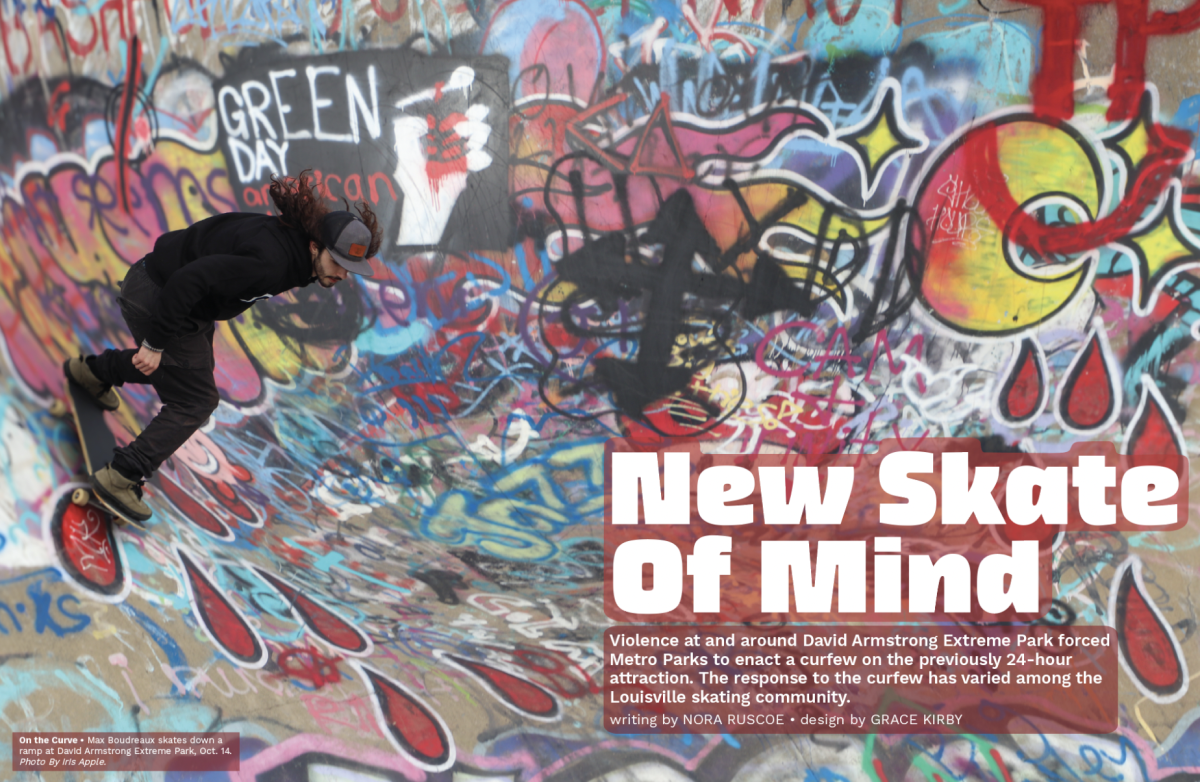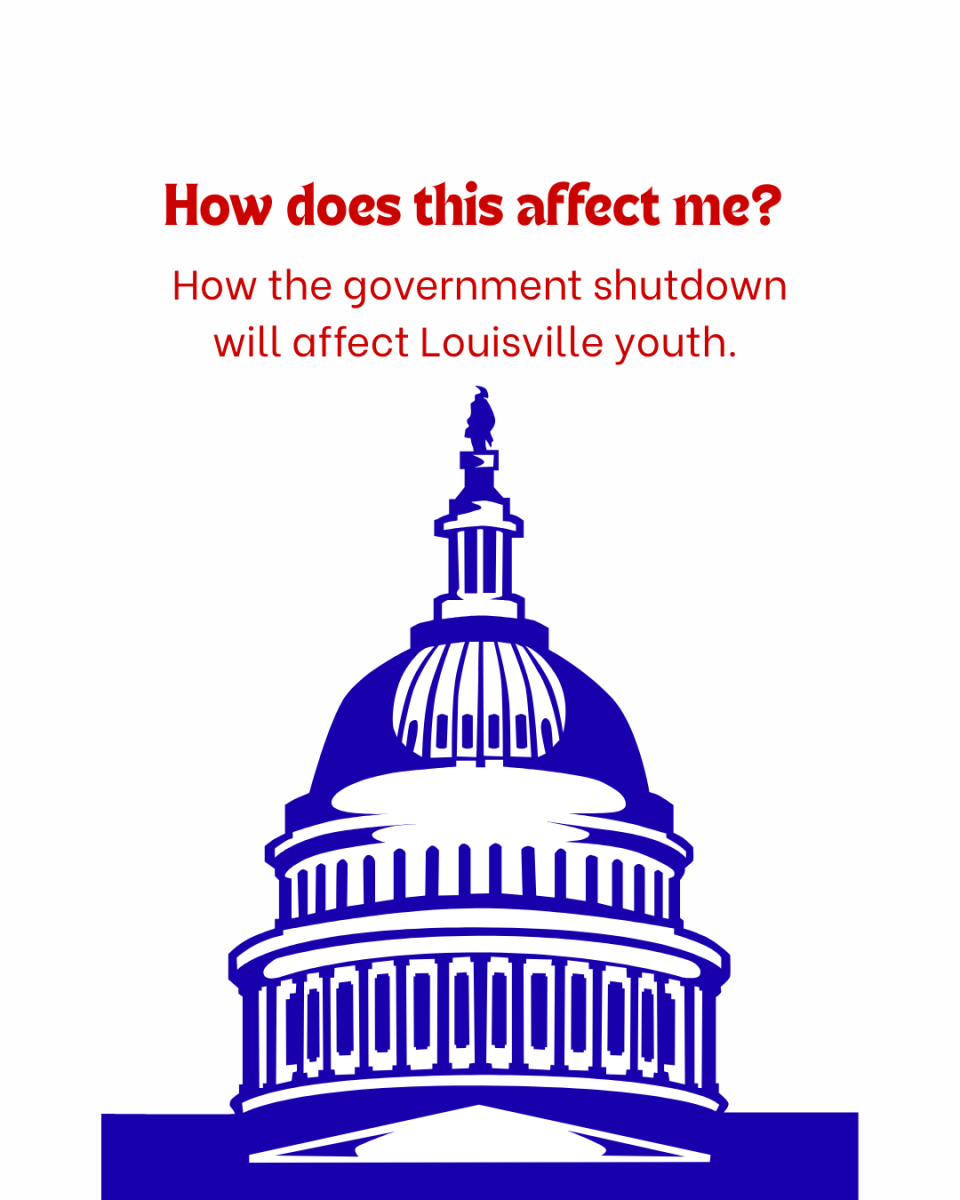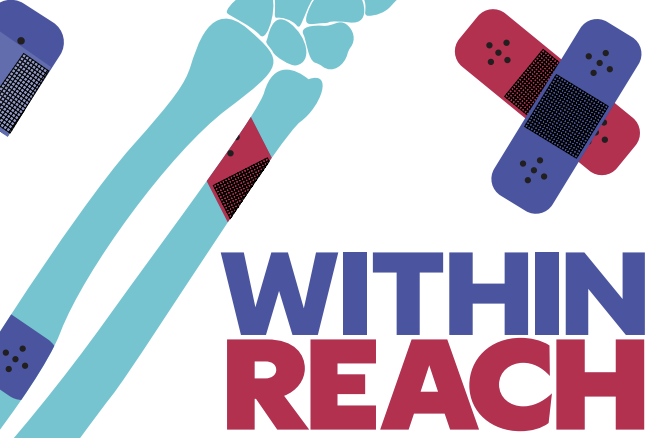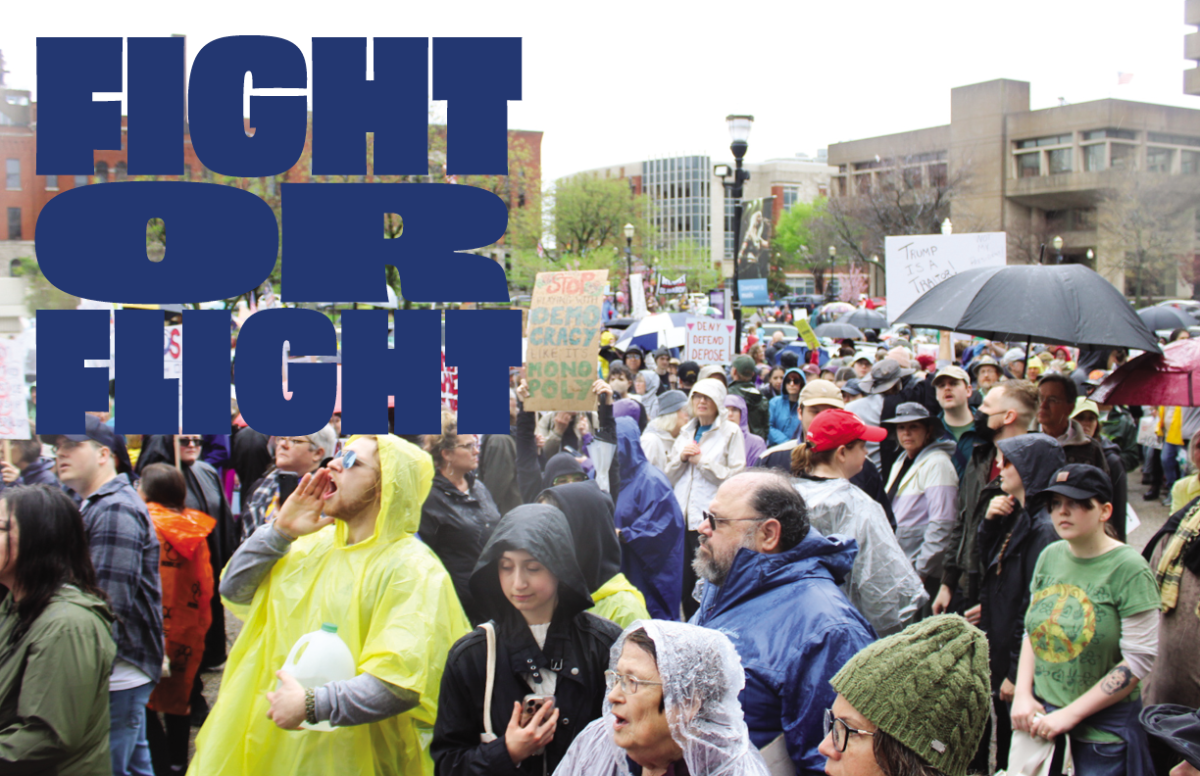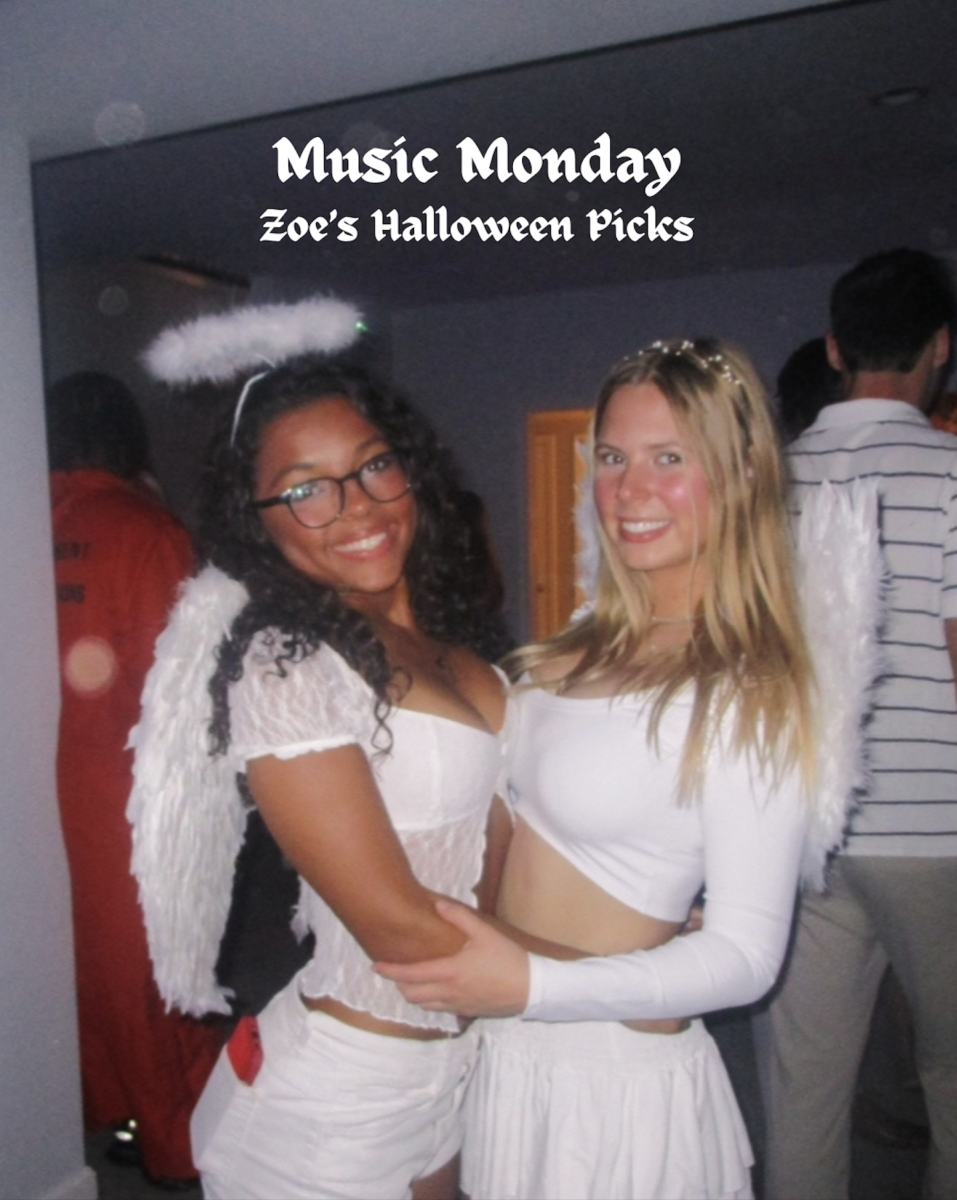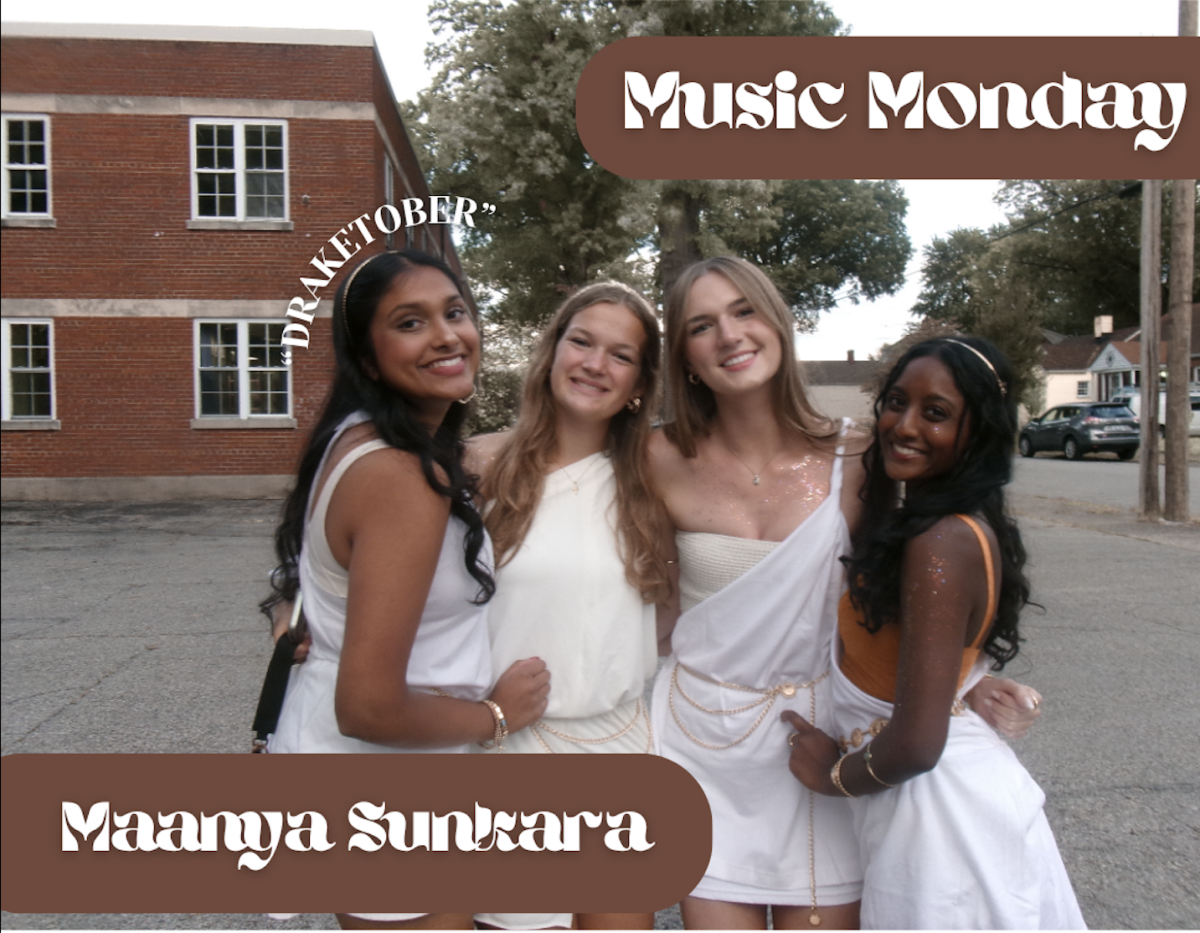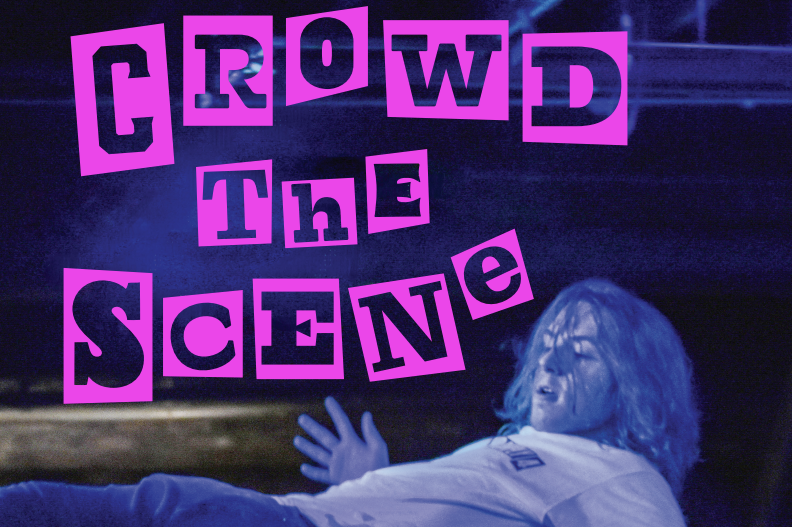writing by NORA RUSCOE • design by GRACE KIRBY
Oct. 21, 2023
First, Beetlejuice walked by. Then came a prisoner, a slice of pizza, and a cowgirl. Groups of people from all over the grounds pooled toward the center, where a 20-foot bowl housed the night’s entertainment.
Ghostface, Jason, and Chucky watched from under the railings that overlooked the spectacle, surrounded by others of all ages. Hundreds of legs dangled over the concrete ledge and bounced against the slope to the sharp beat as a man in green face paint shouted “No Comply three!” over and over into the mic.
Off to the side, costumed skaters glided across the flats and kicked over stairs and ramps, hooting as they landed. Small groups dodged the skaters, laughing and shoving into one another as they angled their chins to eat the biggest bite of pizza they could.
Shoving deeper into the crowd, I hopped up onto one of the ramps and stood on the tips of my toes. Bobbing heads blocked my view, and I shifted from side to side, trying to get a glimpse of the sea of faces below.
The green-faced man handed off the mic to the first act of the night and the music intensified. Warbling, electronic sounds filled the air, and as they got louder, so did the cheers and laughter. Clusters of friends lazed on the grasses, balanced on railings, and posed for pictures.
It was the third annual No Comply concert at the David Armstrong Extreme Park in downtown Louisville, with live music from a handful of bands, complete with a skate and costume contest. In the joyous atmosphere, it might’ve been easy for one to forget the park’s history, to ignore the ever-present undertone that veiled the place, and the fact that it only took a few to disrupt an over 20-year-old tradition.
On July 5, 2023, for the first time since its opening, the lights snapped off at 11 p.m.
But what could have caused this drastic shift?
June 17, 2023
Bullets zipped over the heads of the skaters.
It was around 2 in the morning at the Extreme Park when the fighting broke out, and not long after, the first shots rang out into the night.
A small group of people pressed themselves under the concrete ledges as the gunfire came to a crescendo, some of them angling their phones just above to try and get a glimpse of what was happening. Yells echoed as motorcycles revved in the distance, leaving the skaters stunned and confused after the shooters left the scene.
Two small crowds of people had drawn guns and began shooting into the street and the park. Luckily no one was injured, but over 50 shots were fired in the exchange.
“People were ducking for cover and you could see ricochets, bullets hitting cars, the street, and around the park,” said Matthew Sanders, media and public relations official for the Louisville Metro Police Department (LMPD).
And this wasn’t the end of the violence.
Later that day, a separate brawl broke out in the park.
“We had officers injured and also officers made an arrest on two kids that were carrying AR-15 style weapons in the park,” Sanders said.
Unfortunately, these acts of violence were not a one-time occurance. From concealed weapons to outright gunfire, the park was not spared.
“I don’t want to go down there anymore because I don’t want to get shot,” said Riley Jenkins, a 16-year-old sophomore at Ballard High School who frequented the park.
While overall violent crime in Louisville has decreased in recent years, the skatepark and surrounding neighborhoods have seen an uptick in violence.
“All summer long, LMPD responded to various issues at the Extreme Park,” Sanders said. “It includes people driving dirt bikes within the park, disrupting the skateboarders, fights, gunshots being shot, just overall madness.”
Fearing the violence would continue, officials at LMPD, Louisville Parks and Recreation, and the Louisville Mayor’s Office searched for solutions. Still, making changes at the park had been a long time coming.
“Those two incidents compiled with what happened during the summer at the park was the straw that broke the camel’s back,” Sanders said.
The first step for LMPD was to head back to the park.
“The First Division, downtown area patrol, sent officers there to talk to the skateboarders,” Sanders said. “We wanted their input.”
In addition, the skaters were able to voice their opinions again at numerous city council meetings. Noah Hulsman, the owner of Home Skate Shop, a skateboard shop on Bardstown Road, said that the meetings were filled to the brim with skaters, bikers, roller bladers, and other community members.
“There was no place to sit in there,” Hulsman said.
They discussed many solutions over the course of the next few weeks.
“There was some discussion about putting fencing up and turnstiles around the park, completely fencing it in,” Sanders said.
However, Louisville Parks and Recreation discarded this proposal due to the park being a public space, and they didn’t like the look of forcing everyone who comes into the park to go through a security check.
A more broad approach was to have 24-hour police presence in the area, but this would have put too much of a strain on the department. While they believed safety at the skatepark was important, it wasn’t feasible to have officers patrolling it at all hours of the day.
LMPD had been monitoring the park digitally using cameras installed in 2018 in an effort to keep watch over areas with a high concentration of 911 calls. Crime analysts from LMPD’s Real Time Crime Center were to notify LMPD to dispatch when violence occurred at the park, but they weren’t able to prevent violence before it occurred.
In the end, there was only one proposition that the city believed would fix this issue.
July 5, 2023
Darkness.
For the first time in over 20 years, the David Armstrong Extreme Park was bathed in shadows. The only light came from the gloomy luminescence of the nearby streetlights.
From then on, the lights would be shut off from 11 p.m. to 6 a.m., and no one would be allowed at the park during this time. While this was a major change, the new rule wasn’t actually new at all — Louisville Metro Ordinance 42.32 states that all Louisville parks must follow this time limit. However, the Extreme Park had been exempt for years.
Sanders explained that the city wanted to accommodate those who worked odd hours of the day and couldn’t make it to the park during the daylight hours. Before violence became a pattern at the park, this exemption hadn’t caused problems.
“There were no issues there for several years up until recently,” Sanders said.
After the curfew started being enforced at the park, LMPD began following a few procedures to ensure that those issues didn’t continue.
They allowed for 15-20 minutes of leeway between the shutoff time, 11 p.m., and then patrolled the park periodically throughout the night. If, after the initial sweep, the crime analysts picked up anyone still at the park after hours, LMPD would dispatch once again.
“Most of the time we just remove them from the area, but if there’s other contributing factors, such as drugs or weapons, that would influence an officer’s discretion,” Sanders said.
As of December, LMPD had arrested one person for criminal trespassing at the park after curfew.
Since the enactment of the curfew, the skatepark, local businesses, and random citizens have reportedly called 911 less than before to report violence.
“It’s just different now as new generations come in,” Hulsman said.
April 5, 2002
Voices layered on top of each other in a cacophony of blaring noise as David Armstrong Extreme Park became more packed by the second. R.J. McSorely, a 22-year-old skater, followed the crowd into the park. He’d brought his skateboard, but left it in his car, knowing good and well there would be no room to skate. He glanced over the heads of those around him, trying to picture the park as it had been a week before: empty. On that day, opening day for David Armstrong Extreme Park, the full pipe, half pipe, bowls, and gliding space crawled with people from all over.
“It was completely ridiculous,” McSorely said.
Only after the first few days did it calm down enough for him to use his board.
“Everyone started coming and visiting our park because it was so new and there was nothing like it in the world,” McSorely said.
Though it drew in people from all over, the park had a lasting impact on the residents of Louisville, and, for one boy, it became his future.
Spring 1998
The television glared, making the bikers on the screen appear grainy and pixelated. But that didn’t matter to the 8-year-old who sat before it, perched on the edge of his living room couch, holding onto every frame. The rest of the room disappeared around him — his only focus was on the phenomenon that he decided then and there would be his entire life.
Ever since he was little, Zach Newman had a fascination with wheels. A cart built by his Cub Scout Troup, his Hot Wheels, and wagons — anything that rolled. Biking was just an extension of that fascination.
“Instantly, I needed a ramp of my own,” Newman said.
His parents enrolled him in camps and competitions all over the country to help him fulfill his dream of becoming a professional biker. They also drove Newman from Lexington, his hometown, to the David Armstrong Extreme Park in Louisville, any chance they could. He would bike there for over 10 hours while his dad skated and his mom longboarded.
“All three of us were on some form of wheel,” Newman said.
It was times like these that gave him the skills to further his career. His first sponsor came when he was a senior in high school, and Newman began traveling all over to participate in competitions. It wasn’t until 2018, exactly 20 years after he decided he wanted to be a professional biker, that Newman earned bronze in the BMX Biking X Games, achieving his childhood dream.
“It was weirder afterwards in that I had achieved the goal I had focused most of my life towards and it was, ‘What do I do next?’” Newman said.
His first step? Returning to Louisville, the place that started it all.
“I live in Louisville because of the Dave Armstrong Skatepark,” Newman said firmly.
The Newman family wasn’t the only one to take advantage of the park — BMX teams from across the country mapped their trips throughout the East Coast, making a point to stop in Louisville.
“No matter whether they got ahead of schedule or behind schedule, they could always guarantee on the lights being on and being able to use the park,” Newman said.
There were times when Newman would be hours into biking and suddenly a professional would be skating alongside him — one of them being Pat Miller, a competitor from the first TV program Newman had seen of the sport, the very one that had hooked him.
The park fostered a community that allowed for a wide range of experiences. One could always find groups of friends cheering each other on as they perfected a new trick, a father-son duo bonding over a stunt, or pros skating the park’s ramps.
The friendships created in moments like those aren’t forgotten, even as the people in them grow older or move away. For one Louisville native, it’s those friendships that have persisted long into adulthood and beyond.
1999
Noah Hulsman grew up surrounded by skateboards.
His grandma owned Skateboards Unlimited, a now-closed skate shop on Preston Highway, so he had plenty of exposure, but it wasn’t until he was 11 that he realized his passion for skating.
Growing up beside Atherton High School in the Highlands, Hulsman had plenty of space to glide around with his friends, to “mob around,” as he put it.
David Armstrong Extreme Park opened during his sophomore year of high school, and he found that the park was a great place to work on skills he never would’ve been able to master if he only had access to the streets. It also introduced him to many people that he might never have interacted with.
“It brought so many different kids from so many different neighborhoods to one place,” Hulsman said.
The people he met and skated with at the park became his lifelong friends — his friend group grew up at the park, and sometimes they skated the whole day, sleeping there, and then waking up to another full day of skateboarding.
“I still skate and see friends of mine that I’ve met through that skate park,” Hulsman said.
But the connections formed at the park were far more than just friendships. For others, they were support groups, or people they could rely on to hype them up for their next challenge. Even if they didn’t always succeed, it was the random assortment of people that kept them going.
“These sports are like a family,” Newman said.
That family came from all over. It didn’t matter when they got off work, or how far away they lived. If they wanted to enjoy the park, they could — at any time of the day. That is, until the new hours were enacted.
- • •
Kelli Sulzle, a park regular, disagreed strongly with the curfew. She expressed that it can be hard to get a good amount of exercise when the summer hits.
When Sulzle was diagnosed with Type 1 diabetes, she looked to the skatepark to stay healthy and active. She hated going to the gym, and the park offered her the opportunity to do what she loved and get exercise.
While she understood where they were coming from, Sulzle said that there’s more cons than pros. With the new curfew in place, her time at the park became severely limited.
“The only time you can really come up here and skate is as soon as the sun goes down, and then it’s like as soon as the sun goes down, the park is closing,” Sulzle said.
Concern about the suffocating heat of summer was consistent with many park-goers.
“You can’t skate during the day and we don’t have an indoor skatepark, so you can’t escape the sun,” Hulsman said.
However, it wasn’t the extreme heat that caused much of the protest over the new rule — it was the lack of flexibility.
“A lot of people have jobs and can’t necessarily be out here during daylight hours,” said West Boudreaux, a regular skateboarder at the park.
With the curfew, people were forced to choose between good working hours and free time at the skatepark, leaving some skaters with a choice they wished they didn’t have to make.
But not every parkgoer thought that the curfew was such a bad idea.
Many didn’t like being limited on when they could use the park, but they valued their safety more than their sense of freedom.
“You get people out past 11 and it might kind of be the people that don’t need to be around here, and that could be trouble,” said Michael Conway, a frequent visitor of the park.
Others echoed Conway’s thoughts, stating that they believed the curfew was a good idea, as long as those causing the disturbances stayed out of the park during its open hours as well. Although many didn’t like it, they believed it was the right move.
“It was just the quickest answer that the city could come up with to keep everyone safe,” Hulsman said.
Sanders agreed that it was the most effective way to deal with the problem.
“We’ve had a significant decrease in calls for service or reports of crime at the skatepark here,” Sanders said.
Even though LMPD has reported improvements, many don’t believe that the park will go back to the way it used to be.
“We have no plans to change the times,” said Jon Reiter, a Louisville Parks and Recreation administrator.
Despite the city’s intervention, the park community hasn’t let this new restriction change the ways they used the parks — anyone on a set of wheels still showed up to hang out and have a good time.
For Sulzle, the park is like her second home, and she spends 5-6 hours roller skating there daily.
“When you kind of feel like you don’t have a place to fit in in life, this is the place to fit in and have people,” Sulzle said.
Nov. 18, 2023
Sirens echoed in the distance, reverberating throughout the city. I leaned my forehead against the car window, eyes wandering to the trio of skaters who gathered right at the entrance in an odd circle, each taking turns skating down into the full pipe.
It was 10:30 p.m. on Saturday, a time that might have once had David Armstrong Extreme Park swarming with skaters. Now, only a few people remained.
I kept my eyes glued to the park and felt my anticipation grow as the time ticked on — 10:45, 10:50, 10:55 p.m. As I waited for the final click, I thought back to when I first started learning about the park.
I remembered wondering how the community at the park could still thrive when their hours were cut short, but now, looking out over the skaters, bikers, and scooter riders that cruised across the half pipe, ramps, and flats, I realized that it wasn’t something that switched off with the lights.
As the time neared 11 p.m., people slowly began trickling out of the park, laughing and cracking jokes. Their safety took priority, but it didn’t kill their joy.
In the blink of an eye, the lights snapped off at David Armstrong Extreme Park. •


